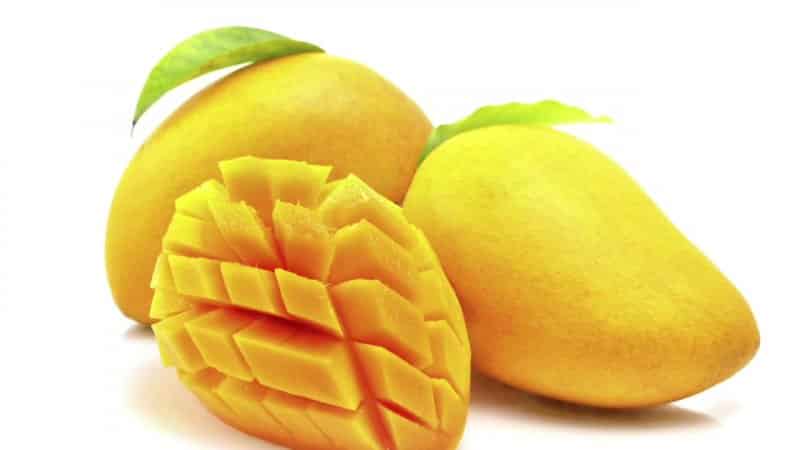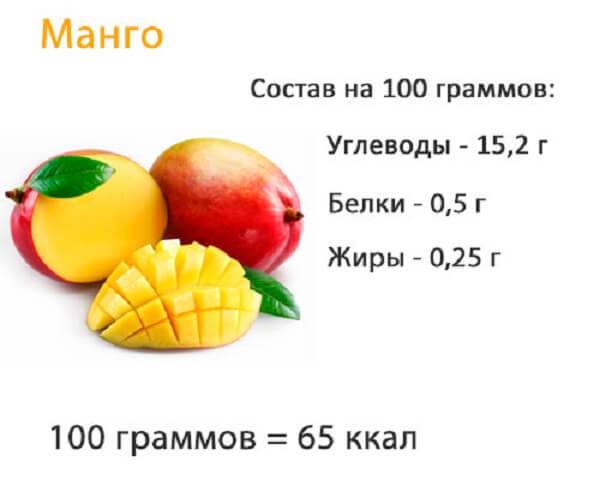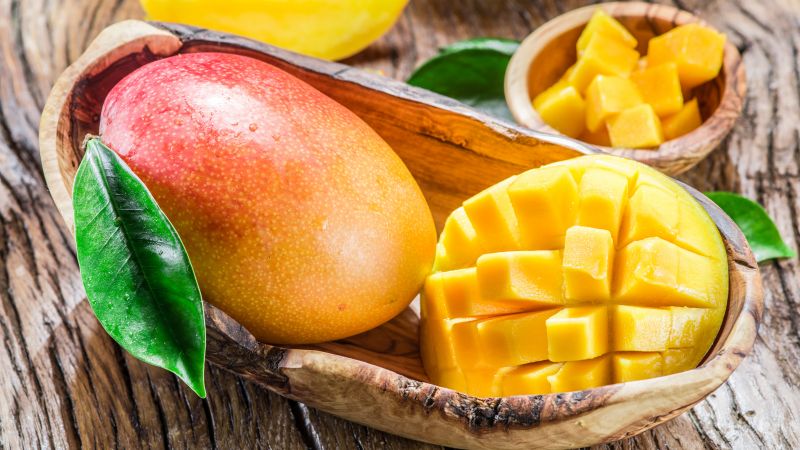What is the calorie content of mango and what are its benefits and harms?
Mango is a popular exotic fruit, which in India is called “royal”. Mango trees are grown on an industrial scale in Asia, South America, a number of African countries and even Europe (for example, on the Canary Islands, part of Spain). Imported products are often found on the shelves of domestic stores. We’ll tell you in more detail why the fruit is beneficial, whether eating it harms your figure, and how to choose a ripe, juicy and tasty mango.
Calorie content, dietary fat and glycemic index

100 g of fresh fruit contains:
- 60 kcal;
- 0.8 g proteins;
- 0.4 g fat;
- 13.4 g carbohydrates;
- 1.6 g fiber;
- 83 g water.
Glycemic index is 55 units - the fruit contains enough simple carbohydrates that cause a jump in blood glucose. This is a borderline value between medium and low GI. And although the product is not dangerous for people with diabetes, consuming it in large quantities is still not recommended.
The carbohydrate composition of ripe and unripe fruits differs:
- As the fruit ripens, the starch contained in the fruit turns into sucrose, maltose and glucose - hence the sweet taste of the product;
- green mango is rich in the complex carbohydrate pectin - as soon as a hard shell is formed, the amount of this substance decreases.
Ripe mango consists mainly of simple, quickly digestible carbohydrates.Unripe fruit contains more dietary fiber, but due to the high content of acids (citric, oxalic, malic and succinic) and the lack of sugars, its taste is low.

Vitamin and mineral composition
What vitamins are contained in 100 g of pulp:
- A - 54 mcg (including beta-carotene - 0.64 mg);
- B1 - 0.028 mg;
- B2 - 0.038 mg;
- B4 - 7.6 mg;
- B5 - 0.197 mg;
- B6 - 0.119 mg;
- B9 - 43 mcg;
- C - 36.4 mg;
- E - 0.9 mg;
- K - 4.2 μg;
- PP - 0.67 mg.
The aroma and taste of unripe mango has a distinct carrot note. And this is not a coincidence at all - both products are rich in carotene (provitamin A) - a pigment that gives the characteristic orange color.
Mango contains few minerals per 100g:
- potassium - 168 mg;
- phosphorus - 14 mg;
- calcium - 11 mg;
- magnesium - 10 mg;
- copper - 111 mcg;
- iron - 0.16 mg;
- zinc - 0.09 mg;
- manganese - 0.063 mg.
100 g of fruit replenishes the daily need for ascorbic acid by 40%, copper - by 11%.
Calorie content of one mango
The weight of an average fruit is from 200 to 300 g, without pits and peel a little less - 150–275 g. In terms of calories, this is approximately 90–165 kcal in one fruit.
How many calories are in processed fruit?

Mango juice contains 50 kcal per 100 ml. However, the lower calorie content compared to the whole fruit should not be misleading: the juice contains more carbohydrates (up to 14 g), and there is practically no fiber.
Dried mango has a high concentration of sugars, which increases the calorie content of the product - 314 kcal per 100 g. Jam from this fruit is slightly less caloric (260 kcal per 100 g), but sugar added during cooking does not increase the benefits of the product.
The same applies to canned mango: although the energy and nutritional value is close to that of fresh fruit (64 kcal and 14 g of carbohydrates), the vitamin and mineral composition becomes noticeably poorer during processing.
Is mango suitable for those losing weight and in what form?

Mango is a faithful ally in the fight against excess weight:
- it contains few calories and virtually no fat (less than 1%);
- thanks to natural sugars in the composition, it dulls cravings for sweets;
- its use removes excess fluid from the body;
- the fruit improves digestion and stimulates metabolic processes.
A significant drawback of the product is the lack of protein (the main building material of the body's cells). What is the best way to eat mango on a diet? To compensate for protein deficiency, nutritionists recommend eating the fruit with low-fat dairy products or adding it to lean meat, poultry and fish. So, a milk-mango smoothie is suitable for a light snack, and chicken breast with vegetables and fruits for dinner.
The benefits and harms of mango
In countries where this exotic fruit grows, it is widely used for medicinal purposes. Beneficial properties of mango:
- strengthens the immune system;
- relieves nervous tension and improves mood;
- has an antioxidant effect;
- stimulates the activity of the kidneys and intestines;
- strengthens blood vessels, stops bleeding;
- reduces cholesterol levels;
- indicated for poor vision;
- regulates blood pressure;
- prevents dehydration (maintains electrolyte, water and acid-base balances);
- considered a natural aphrodisiac.
Contraindications
Despite the impressive list of beneficial effects, the fruit has contraindications and restrictions for use:
- has a strong allergenic effect;
- in immature form causes indigestion, intestinal colic;
- excessive consumption leads to constipation and fever;
- in combination with alcohol, it irritates the gastric mucosa.
The recommended daily intake is no more than 2 fruits per day.
Be especially careful with unripe fruits, as their peel contains the oily toxin urushiol. The same substance is characteristic of cashews, which is why mango and nut pickers wear gloves when handling them.
How to choose and store correctly

Fruits intended for import are picked when they are not yet ripe, so that they do not spoil during transportation. Therefore, Russian stores often sell “green” (in terms of ripeness) mangoes. However, focusing solely on the color of the peel is not always wise, because there are more than 300 varieties of mangoes and each of them has its own color, including dark green. The most reliable sign of fruit ripeness is its smell.
To choose a sufficiently ripe, but unspoiled mango, focus on the following criteria:
- The aroma should be strong and sweet. Alcoholic notes signal that fermentation processes have begun in the fruit.
- Smooth skin with a characteristic glossy sheen and small brown spots is preferred. If the fruit is covered with a network of small wrinkles, it is most likely overripe and will not be stored for long.
- If you press on the fruit, the resulting dent should quickly level out. Loss of elasticity is characteristic of mangoes that begin to deteriorate.
Sometimes it is better to buy a slightly unripe fruit than an overripe one, since it will not be difficult to bring it “to condition” at home.To do this, wrap the fruit in paper or a dry cloth and leave it in a place protected from light for a couple of days.
Important! Mango is sensitive to cold, so for it storage a temperature of at least +10...+13°C and a humidity of about 90–95% are required. Under such conditions, the fruit remains fresh for up to 30 days.
Only those fruits that have already been cut are sent to the refrigerator; their shelf life is 24 hours. To prevent the cut and skin from darkening, sprinkle the mango with lemon juice and wrap it in cling film.
If you can’t finish eating the fruit within a day, it is better to freeze it or add it to confiture. Frozen mango can be stored for 2-3 months without loss of taste and beneficial properties.

Conclusion
It is not for nothing that mango enjoys love and recognition in different parts of the world. In hot countries, this tasty and juicy fruit prevents dehydration, and in the Russian winter it replenishes the supply of vitamins, especially ascorbic acid. The fruit contains few calories and is suitable for dietary nutrition, but it is better to combine it with protein foods.
The surest way to choose a ripe fruit is to focus on the smell. Unripe mangoes are brought to the desired state at room temperature in a place protected from light.